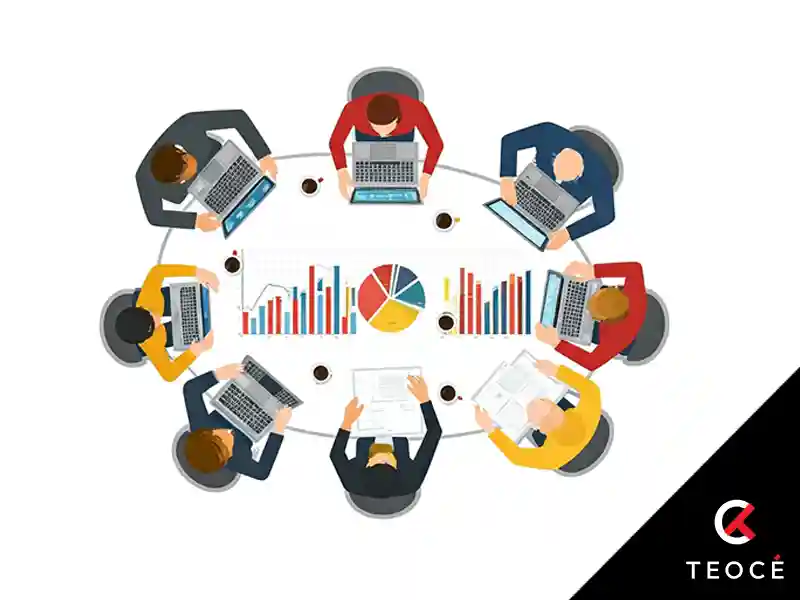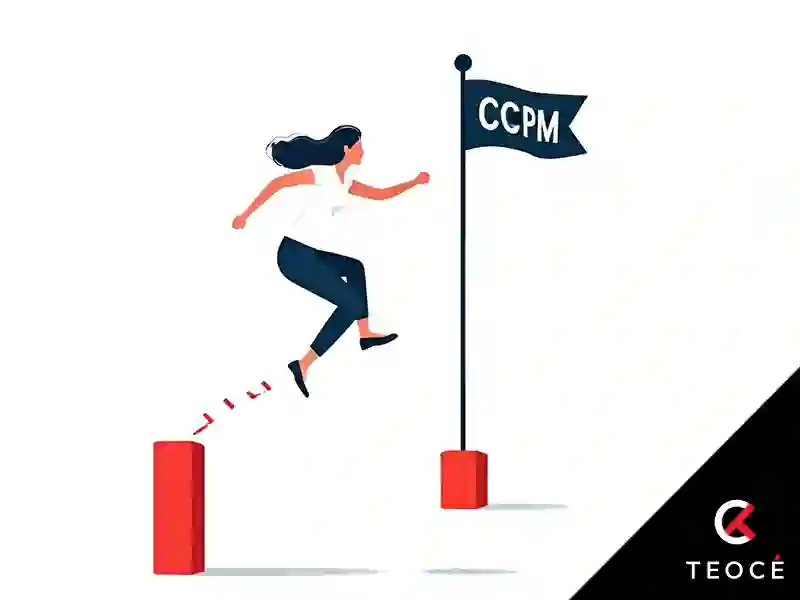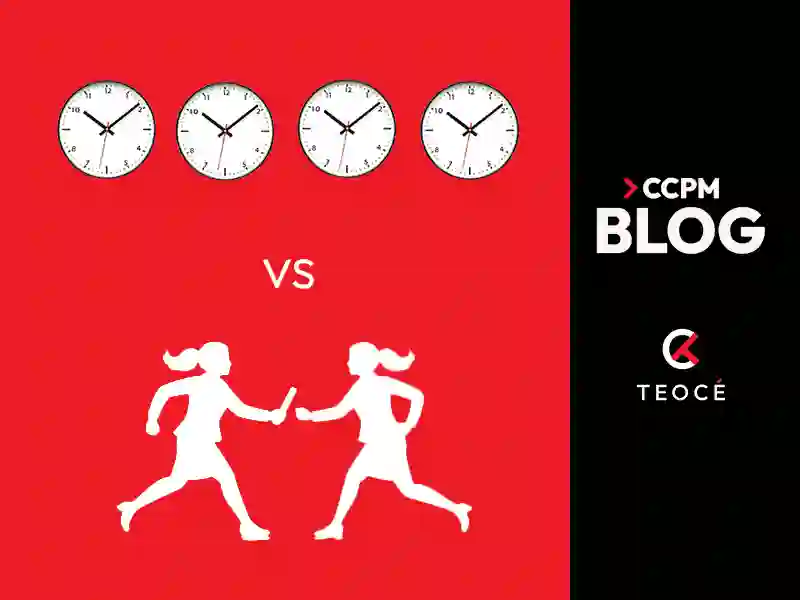Looking to improve how you manage your projects? This comparison between CCPM and milestone-based project management will help you understand why many teams fail to meet deadlines, and which methodology can help you regain control, focus and predictability.
This article compares two ways of managing projects: the classic model based on milestone control and the Critical Chain Management Model (CCPM), focused on the overall delivery flow and speed. We will analyze strengths, limitations, case studies and how to make the leap from one model to the other with real impact.
If you work in demanding environments and are looking to improve your results without adding pressure, this reading offers actionable keys to get there.
Table of Contents
- Why does it matter how we manage projects?
- What is milestone management? Strengths and limitations
- What does the Critical Chain (CCPM) propose? The logic of relay
- What are the key differences between CCPM and milestone management?
- How to make the leap from milestone model to ccpm? Practical recommendations
- last step: from control to flow
- Final summary: two models, two results
Why does it matter how we manage projects?

In an environment where projects are increasingly complex, changing and demanding, it is not enough to have a plan: it matters how we manage it.
Traditional management - based on milestones and protected tasks - is not designed for uncertain environments. Its symptoms are familiar to any project manager:
- Chronic delays.
- Systematic cost overruns.
- Plans that expire after a few days.
- Exhausted and unfocused equipment.
- Dissatisfied customers despite the team's efforts.
Why does this happen? Because people work in "fire-fighting" mode , not in flow mode. Because multitasking, the greatest enemy of productivity, is normalized. And because we continue to prioritize the completion of individual tasks, not the overall progress of the project.
Changing the way you manage changes everything
The Critical Chain Project Management (CCPM) methodology proposes a realistic, humane and efficient alternative. And it has been amply proven.
Implementing CCPM allows:
- Some publications talk about reducing lead times by up to 50% (https://www.cin.ufpe.br), but in our experience, 20% (which is no small amount) is much more realistic.
- Increase delivery predictability.
- Improve the use of shared resources.
- Reduce operational stress.
- Align the team with clear priorities.
- Improve the work environment and customer satisfaction.
- Increases the capacity to take on more projects with the same resources
Managing badly leads to chaos.
Managingwell allows for growth, fulfillment and enjoyment along the way.
What is milestone management? Strengths and limitations
Milestone management is one of the most widespread approaches to project planning. Its logic is simple: if all intermediate milestones are met, the final objective will be met.
The project is divided into chunks or "milestones" with key dates, and is managed like a train with mandatory stops: each milestone is a commitment. If everything is on time, the customer receives his delivery on time.
Perceived strengths
- Segmented commitments: Dividing the project into smaller parts seems to facilitate control and allows each responsible to commit to a clear goal.
- Sense of individual control: People often add safety margins (buffers) to their estimates. This gives them confidence and reinforces the idea that they can deliver what they promise without failure.
Structural limitations (according to the CCPM vision)
From a Critical Chain Project Management perspective, this model presents several profound problems:
- Inefficient buffers: The margin added to each task rarely protects the project. It is wasted by Parkinson's Law (work drags on to fill time) and student syndrome (late starts).
- Destructive multitasking: In order to "get everything done," many people work on several tasks at once. This not only reduces productivity, but also slows down the progress of all tasks.
- Lack of transparency: There is no incentive to finish early or to report real progress. Mistakes are punished but successes are not recognized.
- Reactive management: When a milestone fails, the system reacts late. It improvises, reorganizes, and stress grows.
- Individualistic focus: Everyone protects his or her part, but no one protects the project. Priority is given to "not failing" over "delivering as a whole".
- Plans disconnected from reality: The dependencies between tasks and resources are oversimplified. The plan may look solid on paper, but it does not stand up to the first unforeseen event.
In short, the milestone model promises control, but in practice generates friction, delays and pressure.
Practical example of a milestone-managed project
A simple way to understand how milestone management works is to imagine a project as the management of a train line.
In this model, the objective is not that the train arrives as soon as possible at its final destination, but that it does so punctually, in strict compliance with the established schedules.
Each station represents an intermediate milestone. For the train to "stick to its plan", it is not enough to arrive safely at the destination: it must stop at each station at the scheduled time. Getting ahead of schedule is not allowed, because it also means breaking the commitment.
What is being managed here is not the efficiency of the journey, but the fidelity to the schedule.
This metaphor reflects how the traditional project is conceived:
- Stops (milestones) are defined along the way.
- Progress is measured on the basis of compliance with each.
- Any deviation from the plan, even positive ones, is penalized.
The result: what is rewarded is not speed or flow, but the timely fulfillment of multiple intermediate commitments.
The impact of multitasking and delayed visibility

Two of the most damaging problems in traditional project management are multitasking and lack of early visibility into risks.
Multitasking: the silent enemy in project management
In many teams, it is assumed that working on several tasks or projects at the same time is a sign of efficiency. In reality, the opposite is true.
When a person constantly switches from one task to another:
- Their attention is fragmented.
- Increases the risk of errors.
- The duration of each activity is unnecessarily lengthened.
- And the level of stress and exhaustion rises.
A typical example: if a person has three tasks, each lasting one week, and executes them in parallel, he will not finish any of them until the third week. Result: three delayed projects.
The CCPM approach proposes to eliminate multitasking and encourage focused work: each resource should be 100% dedicated to a single task until it is completed. This speeds up the flow and improves results.
Late visibility: when the problem is already too great
In traditional systems, deviations and risks are detected late, when there is little that can be done. Without a clear baseline of actual progress, projects only reveal their problems on the verge of default.
CCPM solves this with a different strategy: buffer management.
- Instead of measuring by dates or % completed, it is observed how much buffer has been consumed with respect to the progress.
- Visual tools such as the Fever Chart allow early detection of deviations.
- This allows action to be taken before the delay becomes a failure.
Multitasking and late visibility are two sides of the same coin: they make the team work harder, but deliver less.
What does the Critical Chain (CCPM) propose? The logic of relay
The Critical Chain Project Management (CCPM) methodology is a departure from traditional project management methods. Its central principle is simple but powerful: instead of controlling intermediate milestones, the important thing is to move the entire project forward as quickly as possible.
This approach is based on relay logic: each person focuses on a single task, completes it quickly and delivers the result to the next resource without unnecessary delays. There are no strategic stops or step-by-step controls. Just flow.
To make this possible, CCPM introduces several key changes:
- Eliminates multitasking, which fragments attention, slows progress and generates overload.
- Reduce task estimates to a realistic, unprotected duration: one that has a 50% chance of being met if the job is done with full focus.
- It groups safety margins into visible and controlled buffers that protect the entire project.
Types of buffers in CCPM
- Project Buffer: located at the end of the critical chain, it protects the global delivery date against possible delays.
- Feed Buffers: they are placed between the non-critical strings and the main string to avoid delay contagion.
- Active buffer management: it becomes the main control tool. It does not monitor dates, but the consumption of the margin and the actual progress.
This model changes the underlying logic: it is no longer a matter of "everyone doing their own thing", but of the team completing the project with fluidity and shared commitment. Visibility is high, decisions are proactive and the culture is oriented towards collective achievement.
Cultural changes required to implement CCPM
Adopting the Critical Chain Project Management (CCPM) methodology is not only a technical change: it implies a profound transformation in the way of thinking and acting within teams.
The most important step is to leave behind the culture of protected individual commitments. In traditional models, each person estimates with margin "just in case" and defends his or her own delivery, without looking at the whole.
CCPM proposes the opposite: a culture based on collective responsibility for the success of the entire project.
For this change to occur, several key adjustments are required:
- Eliminate multitasking: each person should concentrate 100% on one task until it is completed, and pass the baton without delay.
- Use realistic estimates: tasks are planned with a duration that has a 50% probability of being accomplished, without added protection.
- Actively manage buffers: these shared margins allow uncertainty to be absorbed in a visible and manageable way.
This new approach makes it possible to detect threats before they affect the schedule, overcome the student syndrome and Parkinson's Law, and build an environment where trust, collaboration and focus on what really matters: finishing the project on time.
What are the key differences between CCPM and milestone management?
A picture is worth a thousand explanations. Here is a clear comparison between the traditional milestone management approach and the relay approach proposed by the Critical Chain (CCPM):
| Appearance | Milestone management | Relay management (CCPM) |
|---|---|---|
| Base metaphor | Train line: meet intermediate stops | Relay race: moving fast and without pause |
| Main focus | Meet each intermediate milestone | Finish the entire project faster |
| Task duration | Estimated with individual safety margins | Estimated unprotected (50% compliance) |
| Uncertainty management | Buffer in each task (invisible and wasted) | Visible and strategic buffers at the end |
| Multitasking | Tolerated or habitual | Removed or minimized |
| Common behaviors | Learner's Syndrome, Parkinson's Law | Focused work, early delivery |
| Measuring progress | By milestones 0% completed | By buffer consumption and remaining time |
| Visibility of problems | Late, reactive | Early, proactive (buffer management) |
| Responsibility | Individual, per task | Collective, for the overall result |
| Incentives | Doing "my thing" without overtaking | Finish early and pass the baton |
CCPM does not seek to make each part of the project work separately, but to make the whole flow better.
How to make the leap from milestone model to ccpm? Practical recommendations

Implementing the CCPM methodology is not just a technical change: it requires transforming the management culture and establishing new routines. Here is a clear guide to do it successfully:
Ensures active and visible leadership.
- Management must publicly commit to the change.
- Abandon date-centric reporting; adopt buffer management.
- Leadership must be sustained until the new model is consolidated.
2. Evaluate your current situation
- Diagnose problems: are you meeting deadlines, is multitasking affecting productivity, is there operational stress?
- Define quantifiable objectives: reduce project duration, improve predictability, free up key resources.
3. Plan with relay logic
- Construct the task network visually and consensually, using clear verbs.
- Estimate the actual duration (Focus Duration): minimum time required if the task is a priority and without interruptions.
- Identify the Critical Chain by first resolving resource conflicts.
- Protect the project with shared buffers, not hidden margins:
- Project buffer at the end of the critical chain.
- Feeder buffers where secondary strings are connected to the main string.
4. Synchronize projects in multi-product environments.
- Detect your limiting resource (Pacing Resource): it is usually the organizational bottleneck.
- It schedules from that resource, assigning it priority and a capacity buffer. The rest is synchronized around it.
5. Runs as a relay race
- Eliminates multitasking: total focus on one task until the baton is passed.
- Manage buffers with Fever Chart: visualize consumption and detect threats before they become delays.
- Avoid individual due dates: the only commitment is the end date of the project.
6. Build a culture of trust
- Promotes collective, not individual, responsibility.
- Promotes transparency, collaboration and continuous improvement.
7. Use appropriate tools
- For complex or multi-project environments, consider specialized software such as ProChain.
- Jira can be adapted, but requires advanced configurations and is not intended for CCPM by default.
Every step is an investment in a more synchronized, predictable and focused organization.
last step: from control to flow
The change proposed by Critical Chain Project Management (CCPM) is more than a technique: it is a profound transformation in how we think about and manage projects.
The traditional milestone-based control model
Based on milestones, milestones and individual margins, this model seeks to avoid delays by controlling each phase of the project. But in practice, it generates:
- Multitasking: fragments the focus and lengthens tasks.
- Procrastination and inefficient use of time (Parkinson's Law, Student Syndrome).
- Late visibility of problems.
- Individual success over collective results.
Management becomes reactive, and compliance is measured by intermediate commitments rather than overall impact.
The flow approach with CCPM
CCPM replaces fragmented control with a logic of continuous flow and shared responsibility:
- The work is organized as a relay race: each person focuses 100% on one task and passes it on quickly.
- Estimates are shortened (Focus Duration) and protection is consolidated into visible strategic buffers.
- The Fever Chart makes it possible to anticipate risks and act before they affect delivery.
- There are no individual deadlines, which reduces unproductive pressure and avoids procrastination.
- Early breakthroughs are exploited rather than ignored.
What is achieved?
- Shorter and more predictable projects
- Less stress, more focus
- A collaborative and efficient environment
- A proactive and adaptive management model
Moving from control to flow is not just a technical improvement. It is a cultural leap that transforms the way teams work and deliver value.
Final summary: two models, two results
This comparison between CCPM and traditional management shows that milestone management seeks control. Relay management (CCPM), flow. One measures compliance with deadlines; the other measures speed and system health. The shift from one approach to the other is not just technical: it is a cultural change that transforms how people collaborate, prioritize and deliver value.
In environments with multiple projects, limited resources and high pressure to deliver, CCPM is not just an option: it is a necessary evolution. The good news is that there is a proven methodology, tools available and experiences that demonstrate that change is possible.
Want to explore how this model can transform your project environment? We invite you to take the next step.
